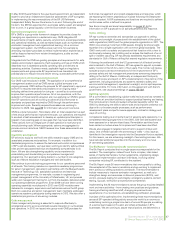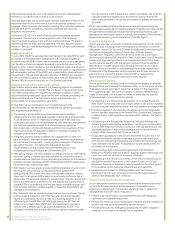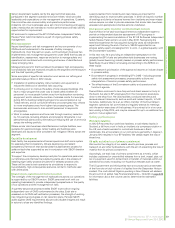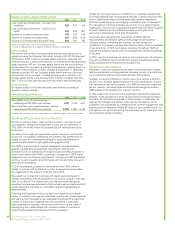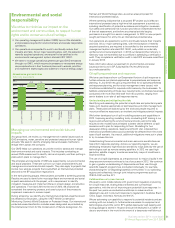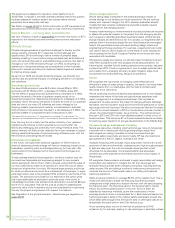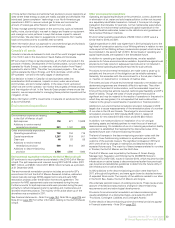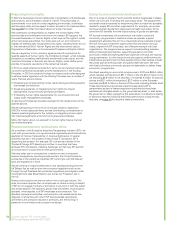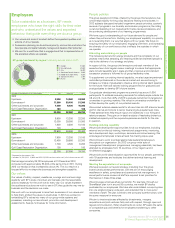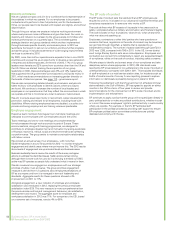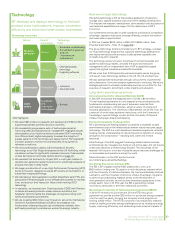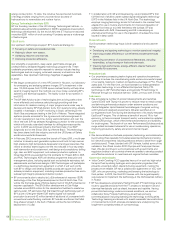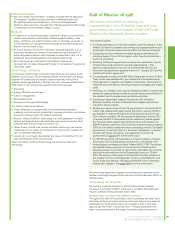BP 2012 Annual Report Download - page 59
Download and view the complete annual report
Please find page 59 of the 2012 BP annual report below. You can navigate through the pages in the report by either clicking on the pages listed below, or by using the keyword search tool below to find specific information within the annual report.
Business review: BP in more depth
Business review: BP in more depth
BP Annual Report and Form 20-F 2012
57
Technology
BP develops and deploys technology to find and
produce more hydrocarbons, improve conversion
efficiency and build new lower-carbon businesses.
Resource
extraction
Activity Point of
competition
Technology
focus
Conversion
t Subsurface understanding
t Standardized engineering
solutions
t Unconventional
hydrocarbons
t Chemical process
technology
t Upgrading refineries
t Lubricants
t Advanced fuels
t Biofuels
Access
Efficiency
Formulation
Feedstocks
and
conversion
technologies
Technology investment
Consumption
Lower
carbon
2012 highlights:
t We spent $674 million on research and development (R&D) in 2012,
supporting business priorities across our portfolio.
t We successfully progressed a suite of technologies aimed at
improving safety and operational risk management. Highlights include:
demonstration of our real-time blowout preventer (BOP) monitoring
tool offshore Brazil; digital radiography to assess the integrity of
subsea systems in the North Sea; and deployment of Permasense®
corrosion probes to monitor the wall thickness of equipment in
refineries in real time.
t We announced plans to deploy LoSal enhanced oil recovery
technology at our Clair Ridge development in the UK North Sea, which
we believe will lead to significantly increased amounts of recoverable
oil (see Salt reduction promises healthy returns on page 17).
t We awarded first contracts for Project 20K, a multi-year initiative to
develop next-generation systems and tools to unlock high pressure oil
and gas resources in deep water.
t We began construction of a new High-Performance Computing (HPC)
centre in Houston, designed to ensure BP remains at the forefront of
subsurface imaging technology.
t We licensed our latest-generation purified terephthalic acid (PTA) and
paraxylene (PX) technologies to non-affiliated third-parties for the first
time, and sold our third licence for Veba combi-cracking (VCC)
technology.
t In lubricants, we launched new Castrol products: EDGE with Titanium
to deliver enhanced protection under extreme conditions; and
Magnatec Hybrid to tackle the challenges of engines working with
hybrid and stop/start powertrains.
t We are investing $100 million over 10 years to set up the International
Centre for Advanced Materials (ICAM) to fund research into
fundamental understanding and use of advanced materials, from
self-healing coatings to membranes, across the energy industry.
How we manage technology
We define technology in BP as the practical application of science to
manage risks, capture business value and inform strategy development.
This includes the research, development, demonstration and acquisition of
new technical capabilities and support for the deployment of BP’s
know-how.
Our investments are focused on safe operations and areas of competitive
advantage: access to resources, process efficiency, product formulation
and lower-carbon opportunities.
In 2012 we invested $674 million in R&D (2011 $636 million). (See
Financial statements – Note 13 on page 210.)
The group technology function provides input to BP’s strategy, oversees
our major technology programmes, supports technology development
and deployment across the company, builds science capability and
conducts long-term research.
The technology advisory council, comprised of eminent business and
academic technology leaders, provides the board and executive
management with an independent view of BP’s capabilities judged
against the highest industrial and scientific standards.
BP has more than 2,000 scientists and technologists across the group,
with seven major technology centres in the US, the UK and Germany.
We also access external expertise through various forms of partnership
and collaboration, from joint research agreements to venturing. We have a
strategic approach to university relationships across our portfolio for the
purposes of research, recruitment, policy insights and education.
Long-term research programmes
International Centre for Advanced Materials (ICAM)
In 2012 BP announced the establishment of ICAM, a $100-million
10-year research partnership to fund research aimed at advancing the
fundamental understanding and use of advanced materials from
self-healing coatings to membranes, across a variety of energy and
industrial applications. The University of Manchester will be the ‘hub’ for
a network of world-class academic institutions, with the University of
Cambridge, Imperial College London and the University of Illinois at
Urbana-Champaign already participating.
Energy Sustainability Challenge (ESC)
BP is partnering with leading research universities to establish trusted
peer-reviewed data on the relationships between natural resource usage
and energy. The ESC is a multi-disciplinary research programme, aimed at
building a better understanding of natural resource constraints on energy
production and consumption – including land, water and mineral
resources.
Initial findings of the ESC suggest that energy-related natural resource
constraints can be managed, but doing so will not be easy, and will require
wise policy decisions and technology choices. The next phase of the
research will focus on a number of specific natural resource challenges for
our businesses and operations across the world.
More information on the ESC can be found at
bp.com/energysustainabilitychallenge.
The Energy Biosciences Institute (EBI)
The EBI is BP’s largest external R&D collaboration, with up to
$500-million funding over 10 years for a multi-disciplinary research effort
with the University of California Berkeley, the Lawrence Berkeley National
Laboratory, and the University of Illinois at Urbana-Champaign. Its goal is
to perform groundbreaking research aimed at the development of
next-generation biofuels, as well as other bioscience applications to the
energy sector. Now in its fifth year, the EBI is generating multiple
innovations, particularly in the field of cellulosic conversion.
Massachusetts Institute of Technology Energy Initiative (MITEI)
In 2012 BP renewed its commitment to the MITEI through an
agreement to provide another $25 million for continued energy research
over the next five years, bringing the company’s total programme
funding to $50 million. The MITEI conducts multi-disciplinary research
aimed at tackling complex energy challenges such as increasing energy
supply, improving efficiency, and addressing environmental impacts of


